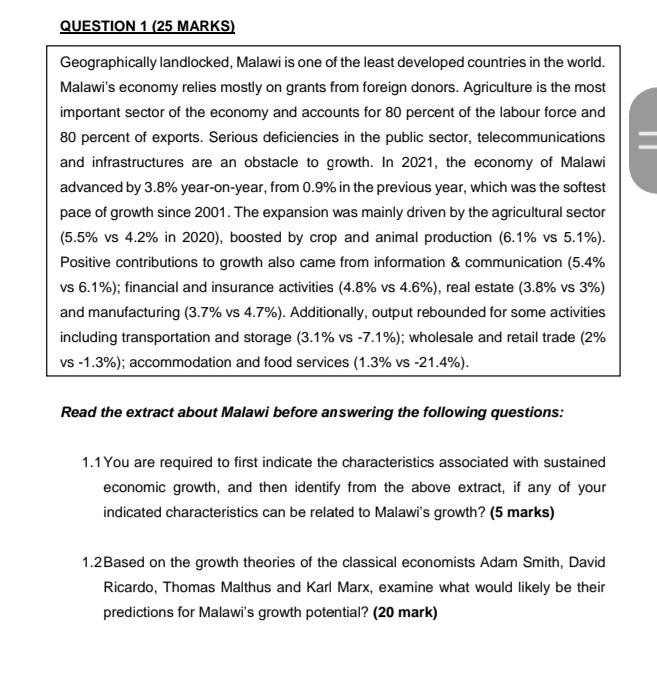
Geographically landlocked, Malawi is one of the least developed countries in the world. Malawi's economy relies mostly on grants from foreign donors. Agriculture is the most important sector of the economy and accounts for 80 percent of the labour force and 80 percent of exports. Serious deficiencies in the public sector, telecommunications and infrastructures are an obstacle to growth. In 2021, the economy of Malawi advanced by 3.8% year-on-year, from 0.9% in the previous year, which was the softest pace of growth since 2001 . The expansion was mainly driven by the agricultural sector (5.5\% vs 4.2% in 2020), boosted by crop and animal production (6.1\% vs 5.1%). Positive contributions to growth also came from information \& communication (5.4% vs 6.1%); financial and insurance activities (4.8\% vs 4.6%), real estate ( 3.8% vs 3%) and manufacturing ( 3.7% vs 4.7% ). Additionally, output rebounded for some activities including transportation and storage (3.1% vs 7.1%); wholesale and retail trade (2% vs 1.3%); accommodation and food services (1.3% vs 21.4%). Read the extract about Malawi before answering the following questions: 1.1You are required to first indicate the characteristics associated with sustained economic growth, and then identify from the above extract, if any of your indicated characteristics can be related to Malawi's growth? (5 marks) 1.2Based on the growth theories of the classical economists Adam Smith, David Ricardo, Thomas Malthus and Karl Marx, examine what would likely be their predictions for Malawi's growth potential? (20 mark) Geographically landlocked, Malawi is one of the least developed countries in the world. Malawi's economy relies mostly on grants from foreign donors. Agriculture is the most important sector of the economy and accounts for 80 percent of the labour force and 80 percent of exports. Serious deficiencies in the public sector, telecommunications and infrastructures are an obstacle to growth. In 2021, the economy of Malawi advanced by 3.8% year-on-year, from 0.9% in the previous year, which was the softest pace of growth since 2001 . The expansion was mainly driven by the agricultural sector (5.5\% vs 4.2% in 2020), boosted by crop and animal production (6.1\% vs 5.1%). Positive contributions to growth also came from information \& communication (5.4% vs 6.1%); financial and insurance activities (4.8\% vs 4.6%), real estate ( 3.8% vs 3%) and manufacturing ( 3.7% vs 4.7% ). Additionally, output rebounded for some activities including transportation and storage (3.1% vs 7.1%); wholesale and retail trade (2% vs 1.3%); accommodation and food services (1.3% vs 21.4%). Read the extract about Malawi before answering the following questions: 1.1You are required to first indicate the characteristics associated with sustained economic growth, and then identify from the above extract, if any of your indicated characteristics can be related to Malawi's growth? (5 marks) 1.2Based on the growth theories of the classical economists Adam Smith, David Ricardo, Thomas Malthus and Karl Marx, examine what would likely be their predictions for Malawi's growth potential? (20 mark)







